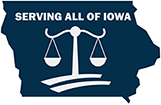Last Updated: 2/10/2025
If you live in Iowa, it’s important that you know the laws of the state. One set of laws that can be pertinent to safety are the laws regarding cyclists. Whether you consider yourself to be an avid biker or prefer to use streets via vehicle, knowing the rules of the road is critical. The following reviews bicycle laws in Iowa, all of which cars (when applicable) and cyclists must abide.
Pass on the Left
Just like vehicles, bicyclists are required to pass cars on the left if passing is necessary. According to Iowa bicycle law, to pass a motor vehicle, a bicycle must first move into the left lane. After ensuring that it is safe to pass, the bicycle may pass, but then must move back into the right lane.
Ride With Traffic, Not Against It
Another law that cyclists must abide by, which doesn’t affect pedestrians on sidewalks, is always to ride in the same direction that traffic is traveling. Riding on the wrong side of the road isn’t only illegal, but it also increases the chances that a deadly head-on collision could occur.
Always Use a Light When It’s Dark Out
Any rider that is riding a bicycle after sunset or before sunrise must use bike lights. Iowa law stipulates that a bike must be equipped with “lamp on the front exhibiting a white light and a red light or reflector on the rear.” Both lights must be visible for a minimum distance of at least 300 feet. Using a light helps a cyclist to see the road and know where they’re traveling, and it also helps to increase the cyclist’s ability to be seen by other motorists.
Stop for School Buses
Some cyclists might assume that because they’re on a bike, they don’t have to stop for school buses. However, Iowa law requires that all modes of transportation stop for buses when a bus has its stop sign displayed or its lights flashing. Failing to stop is against the law, and can result in a traffic citation.
Use Proper Hand and Arm Signals
While bicycles may not come equipped with the same sort of signaling devices as cars do, signals are still required under the law. Cyclists should familiarize themselves with and use the proper hand and arm signals.
These signals include the following listed below.
- Left turn: left arm extended horizontally
- Right turn: left arm bent at the elbow, hand facing upwards
- Slow down/stop: left arm bent at the elbow, hand facing downwards
All signals should be made with the left arm so that motorists can clearly see the signals.
Always Report Traffic Crashes
Iowa law also requires that cyclists report all traffic crashes. Cyclists are also required to exchange information with the other party involved in the event of an accident.
Never Ride in Non-Bicycle Areas
Not all areas in the state that are open to motor vehicles are open to bicyclists. While nearly all neighborhood and main roads permit cyclists, interstates are banned for those on bikes. Some highways are also off-limits to cyclists for safety reasons. Also, keep in mind that many cities within Iowa prohibit a cyclist from riding on the sidewalk.
Learn Iowa’s Bicycle Laws and What to Do if You’re in a Cycling Accident
Learning Iowa’s bicycling laws are important to safety. However, not everyone follows bicycle and traffic laws as they should. When a motor vehicle fails to drive safely and within the parameters of the law, causing an accident, action should be taken.
At Walker, Billingsley & Bair, our attorneys can guide you through everything you need to know about filing an insurance claim or a personal injury lawsuit. Contact us at (888) 435-9886 to meet with us for free today.


